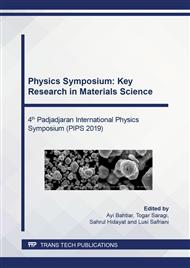[1]
A. Rahman, A review on semiconductors including applications and temperature effects in semiconductors, Am. Sci. Res. J. Eng. Technol. 7 (2014) 50-70.
Google Scholar
[2]
W. Liu, H. Ma, A. Walsh, Advance in photonic crystal solar cells, Renew. Sustain. Energy Rev. 116 (2009) 109436.
Google Scholar
[3]
K. Mochizuki, One-dimensional models for diffusion and segregation of boron and ion implantation of aluminum in 4H-silicon carbide, in: R. Gerhardt (Ed.), Properties and Applications of Silicon Carbide, INTECH Open Access Publisher, (2011).
DOI: 10.5772/14553
Google Scholar
[4]
J. Robertson, Hard amorphous (diamond-like) carbons, Prog. Solid State Chem. 21 (1991)199–333.
DOI: 10.1016/0079-6786(91)90002-h
Google Scholar
[5]
J. R. Creighton, P. Ho, Introduction to chemical vapour deposition, Chem. Vap. Deposition 2 (2001) 1-22.
Google Scholar
[6]
A. Baptista, F. Silva, J. Porteiro, J. Míguez, G. Pinto, Sputtering physical vapour deposition (PVD) coatings: a critical review on process improvement and market trend demands, Coatings 8 (2018), 402 (22 pages).
DOI: 10.3390/coatings8110402
Google Scholar
[7]
P. Mahtani, Optical and structural characterization of amorphous carbon films, Master Thesis, University of Toronto, Canada, 2010, http://hdl.handle.net/1807/24267.
Google Scholar
[8]
D. I. Pamungkas, Mukarromah, B. Priyanto, H. Nakajima, S. Tunmee, Darminto, Structural analysis and electrical properties of amorphous carbon thin films, Mater. Sci. Forum 966 (2019) 66–71.
DOI: 10.4028/www.scientific.net/msf.966.66
Google Scholar
[9]
Mukarromah, D. I. Pamungkas, Darminto, Structural characterization of amorphous carbon films from palmyra sap, Proceeding of International Conference on Biology and Applied Science (ICOBAS), Malang, Indonesia, 2019, p.050011.
DOI: 10.1063/1.5115687
Google Scholar
[10]
B.S. Yilbas, A. Al-Sharafi, H. Ali, Self-Cleaning of Surfaces and Water Droplet Mobility, First ed., Elsevier, The Netherland, (2019).
DOI: 10.1016/b978-0-12-814776-4.00003-3
Google Scholar
[11]
S.C. Ray, W. Mbiombi, P. Papakonstantinou, Electrical and electronic properties of nitrogen doped amorphous carbon (a-CNx) thin films, Curr. Appl. Phys. 14 (2014) 1845–1848.
DOI: 10.1016/j.cap.2014.10.016
Google Scholar
[12]
J. Podder, M. Rusop, T. Soga, T. Jimbo, Boron doped amorphous carbon thin films grown by R.F. PECVD under different partial pressure, Diam. Relat. Mater. 14 (2005) 1799–1804.
DOI: 10.1016/j.diamond.2005.07.020
Google Scholar
[13]
C. Ronning, U. Griesmeier, M. Gross, H.C. Hofsäss, R.G. Downing, G.P. Lamaze, Conduction processes in boron- and nitrogen-doped diamond-like carbon films prepared by mass-separated ion beam deposition, Diam. Relat. Mater. 4 (1995) 5–6.
DOI: 10.1016/0925-9635(94)05219-0
Google Scholar
[14]
S. Zhuiykov, Nanostructured Semiconductor Oxides for the Next Generation of Electronics and Functional Devices, First ed., Elsevier, The Netherland, (2014).
DOI: 10.1016/b978-1-78242-220-4.50014-7
Google Scholar
[15]
H. Oh, K. Cho, S. Kim, Effect of deposition pressure on the electrical properties of nitrogen-doped amorphous carbon films, J. Korean. Phys. Soc. 67 (2015) 638–42.
DOI: 10.3938/jkps.67.638
Google Scholar
[16]
S. Benramache, O. Belahssen, A. Guettaf, A. Arif, Correlation between electrical conductivity—optical band gap energy and precursor molarities ultrasonic spray deposition of ZnO thin films, J. Semicond. 34 (2013) 113001.
DOI: 10.1088/1674-4926/34/11/113001
Google Scholar
[17]
S.M. Sze, Semiconductor Devices, Physics and Technology, Second ed., Wiley New York, (2002).
Google Scholar
[18]
B. Sawicki, E. Tomaszewicz, M. Piątkowska, T. Groń, H. Duda, K. Górny, Correlation between the band-gap energy and the electrical conductivity in MPr2W2O10 tungstates (where M = Cd, Co, Mn), Acta Phys. Pol. A 129 (2016) A94-A96.
DOI: 10.12693/aphyspola.129.a-94
Google Scholar


